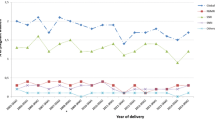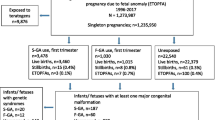Abstract
Purpose
The objective of this exposed–unexposed study was to evaluate potential effects of dopamine agonists during pregnancy.
Methods
Data from EFEMERIS, a cohort of 57,408 pregnant women living in South West France, were used to compare exposed and unexposed women. The exposed group included 183 women (0.3 %) who received at least one prescription for one dopamine agonist during pregnancy. These women were individually matched with two unexposed women from the cohort for age and the month-and-year of the start of pregnancy. Pregnancy losses, birth defects, preterm births, low birth weight and psychomotor development were studied.
Results
Bromocriptine was the most frequently prescribed dopamine agonist, followed by cabergoline and quinagolide. Most (75 %) of the dopamine agonists were prescribed at the beginning of pregnancy (first trimester). There was no difference between the two groups concerning pregnancy history and demographic data. After adjustment for potential confounders, prescription and dispensation of dopamine agonists was associated with an increased risk of pregnancy loss [PORa = 3.7; 95 % confidence interval (CI) 1.8–7.4] and preterm birth (PORa = 3.6; 95 % CI 1.5–8.3). The prevalence of birth defects and low birth weight was not significantly different between the two groups. No difference in psychomotor development at either 9 or 24 months was observed between the two groups.
Conclusion
This study suggests that prenatal exposure to dopamine agonists may be associated with an increased risk of pregnancy loss and preterm birth.

Similar content being viewed by others
References
Kars M, Souverein PC, Herings RMC et al (2009) Estimated age- and gender-specific incidence and prevalence of dopamine agonist-treated hyperprolactinemia. J Clin Endocrinol Metab 94(8):2729–2734
Elbaz A, Bower JH, Maraganore DM et al (2002) Risk tables for parkinsonism and Parkinson’s disease. J Clin Epidemiol 55(1):25–31
Sundström E, Kölare S, Souverbie F et al (1993) Neurochemical differentiation of human bulbospinal monoaminergic neurons during the first trimester. Brain Res Dev Brain Res 75(1):1–12
Herlenius E, Lagercrantz H (2004) Development of neurotransmitter systems during critical periods. Exp Neurol 190(Suppl 1):S8–S21
Lacroix I, Hurault C, Sarramon MF et al (2009) Prescription of drugs during pregnancy: a study using EFEMERIS, the new French database. Eur J Clin Pharmacol 65(8):839–846
Beck S, Wojdyla D, Say L et al (2010) The worldwide incidence of preterm birth: a systematic review of maternal mortality and morbidity. Bull World Health Org 88(1):31–38
WHO health status statistics: morbidity. http://www.who.int/healthinfo/statistics/indlowbirthweight/en/index.html. Accessed 17 Dec 2012
Les certificats de santé aux 8e jour, 9e mois et 24e mois—Drees—Ministère des Affaires sociales et de la Santé. http://www.drees.sante.gouv.fr/les-certificats-de-sante-aux-8e-jour-9e-mois-et-24e-mois,7333.html. Accessed 18 Feb 2013
Krupp P, Monka C (1987) Bromocriptine in pregnancy: safety aspects. Klin Wochenschr 65(17):823–827
Stalldecker G, Mallea-Gil MS, Guitelman M et al (2010) Effects of cabergoline on pregnancy and embryo-fetal development: retrospective study on 103 pregnancies and a review of the literature. Pituitary 13(4):345–350
Colao A, Abs R, Bárcena DG, Chanson P, Paulus W, Kleinberg DL (2008) Pregnancy outcomes following cabergoline treatment: extended results from a 12-year observational study. Clin Endocrinol (Oxf) 68(1):66–71
Ricci E, Parazzini F, Motta T et al (2002) Pregnancy outcome after cabergoline treatment in early weeks of gestation. Reprod Toxicol 16(6):791–793
Källen B, Olausson Otterblad P, Danielsson BR (2005) Is erythromycin therapy teratogenic in humans? Reprod Toxicol 20(2):209–214
Turkalj I, Braun P, Krupp P (1982) Surveillance of bromocriptine in pregnancy. JAMA 247(11):1589–1591
Estan L, Berenquer A, Martinez-Mir I, Rubio E, Morales-Olivas FJ (1993) Response to dopamine agonists of the rat isolated uterus. Gen Pharmacol 24:397–401
Estan L, Martinez-Mir I, Rubio E, Morales-Olivas FJ (1988) Relaxant effect of dopamine on the isolated rat uterus. Naunyn Schmiedebergs Arch Pharmacol 338:484–488
Gobello C (2006) Dopamine agonists, anti-progestins, anti-androgens, long-term-release GnRH agonists and anti-estrogens in canine reproduction: a review. Theriogenology 66:1560–1567
Conflict of interest
We declare that we have no conflict of interest.
Author information
Authors and Affiliations
Corresponding author
Electronic supplementary material
Below is the link to the electronic supplementary material.
Rights and permissions
About this article
Cite this article
Hurault-Delarue, C., Montastruc, JL., Beau, AB. et al. Pregnancy outcome in women exposed to dopamine agonists during pregnancy: a pharmacoepidemiology study in EFEMERIS database. Arch Gynecol Obstet 290, 263–270 (2014). https://doi.org/10.1007/s00404-014-3210-z
Received:
Accepted:
Published:
Issue Date:
DOI: https://doi.org/10.1007/s00404-014-3210-z




